Research Proposal: Analyzing Employee Turnover at Genting Group
VerifiedAdded on 2023/05/30
|22
|7219
|50
Report
AI Summary
This research proposal investigates the impact of employee turnover on the productivity of the Genting Group in Malaysia. It aims to understand the concept of employee turnover, evaluate its relationship with productivity, analyze the factors affecting turnover within the Genting Group, and recommend strategies to mitigate it. The study reviews existing literature on employee turnover, exploring its causes, consequences, and potential solutions. The research methodology outlines the study's design, approach, data collection methods, and analysis techniques. Expected findings are discussed, highlighting the potential implications for the hospitality sector and other industries. The proposal concludes by emphasizing the significance of the study for academics, managers, and the Genting Group itself.
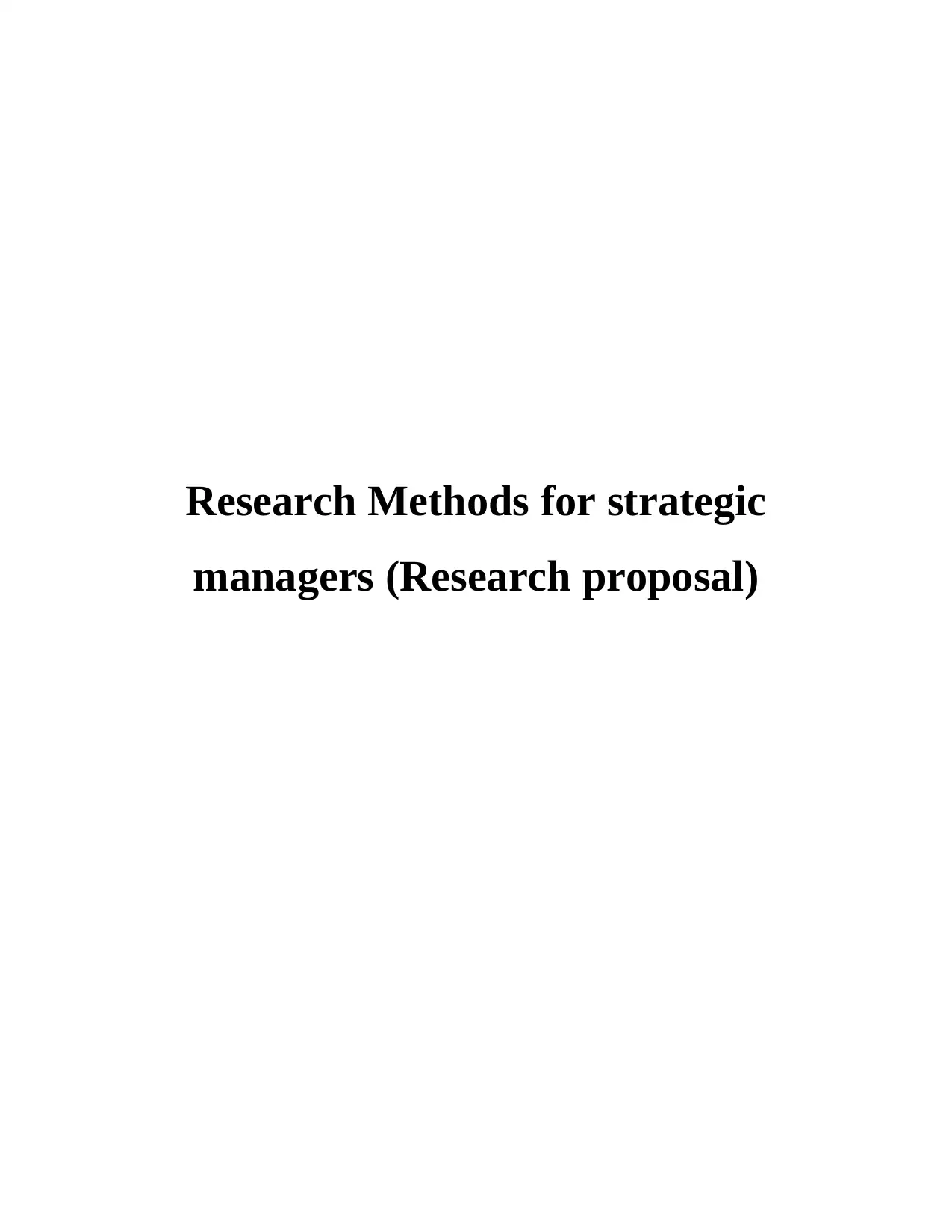
Research Methods for strategic
managers (Research proposal)
managers (Research proposal)
Paraphrase This Document
Need a fresh take? Get an instant paraphrase of this document with our AI Paraphraser
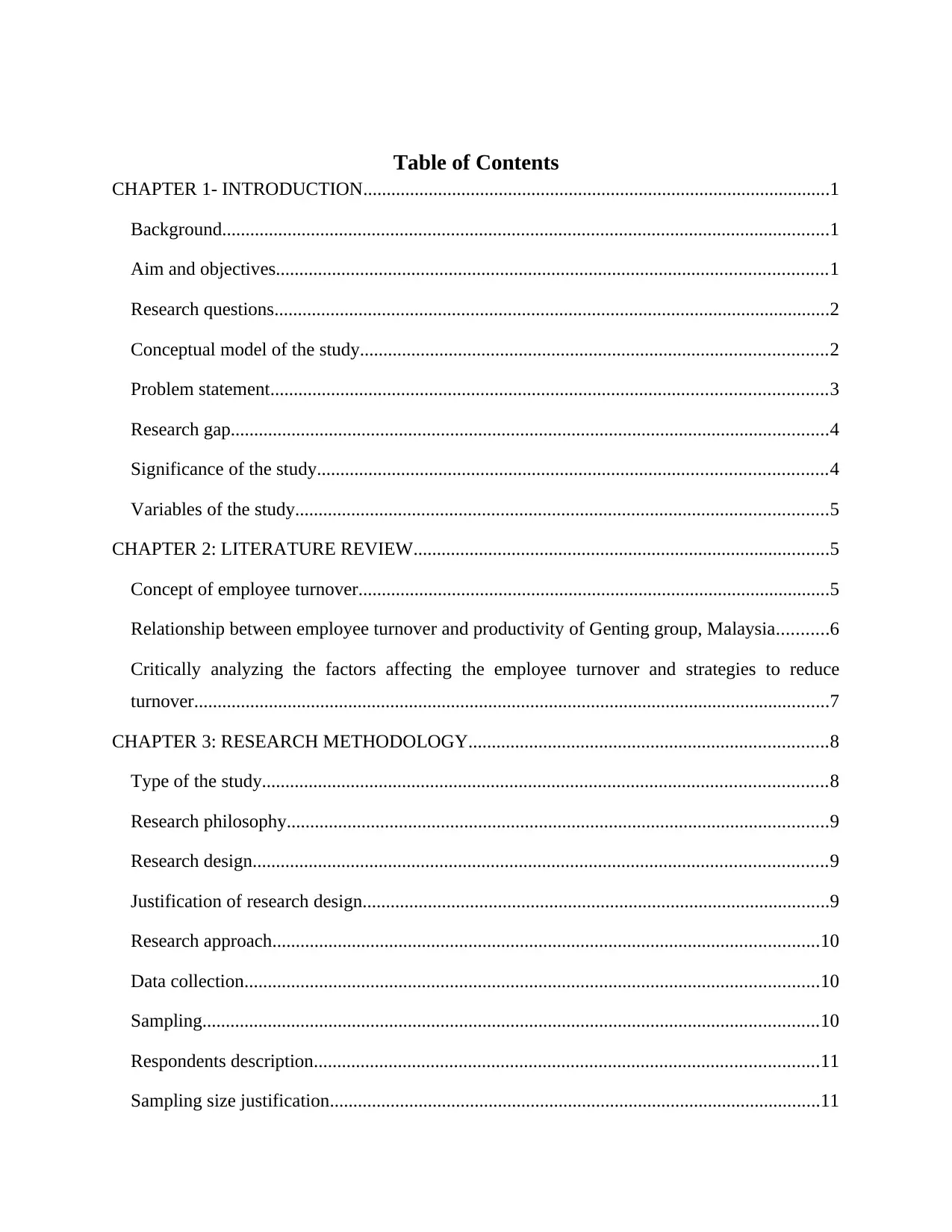
Table of Contents
CHAPTER 1- INTRODUCTION....................................................................................................1
Background..................................................................................................................................1
Aim and objectives......................................................................................................................1
Research questions.......................................................................................................................2
Conceptual model of the study....................................................................................................2
Problem statement.......................................................................................................................3
Research gap................................................................................................................................4
Significance of the study.............................................................................................................4
Variables of the study..................................................................................................................5
CHAPTER 2: LITERATURE REVIEW.........................................................................................5
Concept of employee turnover.....................................................................................................5
Relationship between employee turnover and productivity of Genting group, Malaysia...........6
Critically analyzing the factors affecting the employee turnover and strategies to reduce
turnover........................................................................................................................................7
CHAPTER 3: RESEARCH METHODOLOGY.............................................................................8
Type of the study.........................................................................................................................8
Research philosophy....................................................................................................................9
Research design...........................................................................................................................9
Justification of research design....................................................................................................9
Research approach.....................................................................................................................10
Data collection...........................................................................................................................10
Sampling....................................................................................................................................10
Respondents description............................................................................................................11
Sampling size justification.........................................................................................................11
CHAPTER 1- INTRODUCTION....................................................................................................1
Background..................................................................................................................................1
Aim and objectives......................................................................................................................1
Research questions.......................................................................................................................2
Conceptual model of the study....................................................................................................2
Problem statement.......................................................................................................................3
Research gap................................................................................................................................4
Significance of the study.............................................................................................................4
Variables of the study..................................................................................................................5
CHAPTER 2: LITERATURE REVIEW.........................................................................................5
Concept of employee turnover.....................................................................................................5
Relationship between employee turnover and productivity of Genting group, Malaysia...........6
Critically analyzing the factors affecting the employee turnover and strategies to reduce
turnover........................................................................................................................................7
CHAPTER 3: RESEARCH METHODOLOGY.............................................................................8
Type of the study.........................................................................................................................8
Research philosophy....................................................................................................................9
Research design...........................................................................................................................9
Justification of research design....................................................................................................9
Research approach.....................................................................................................................10
Data collection...........................................................................................................................10
Sampling....................................................................................................................................10
Respondents description............................................................................................................11
Sampling size justification.........................................................................................................11
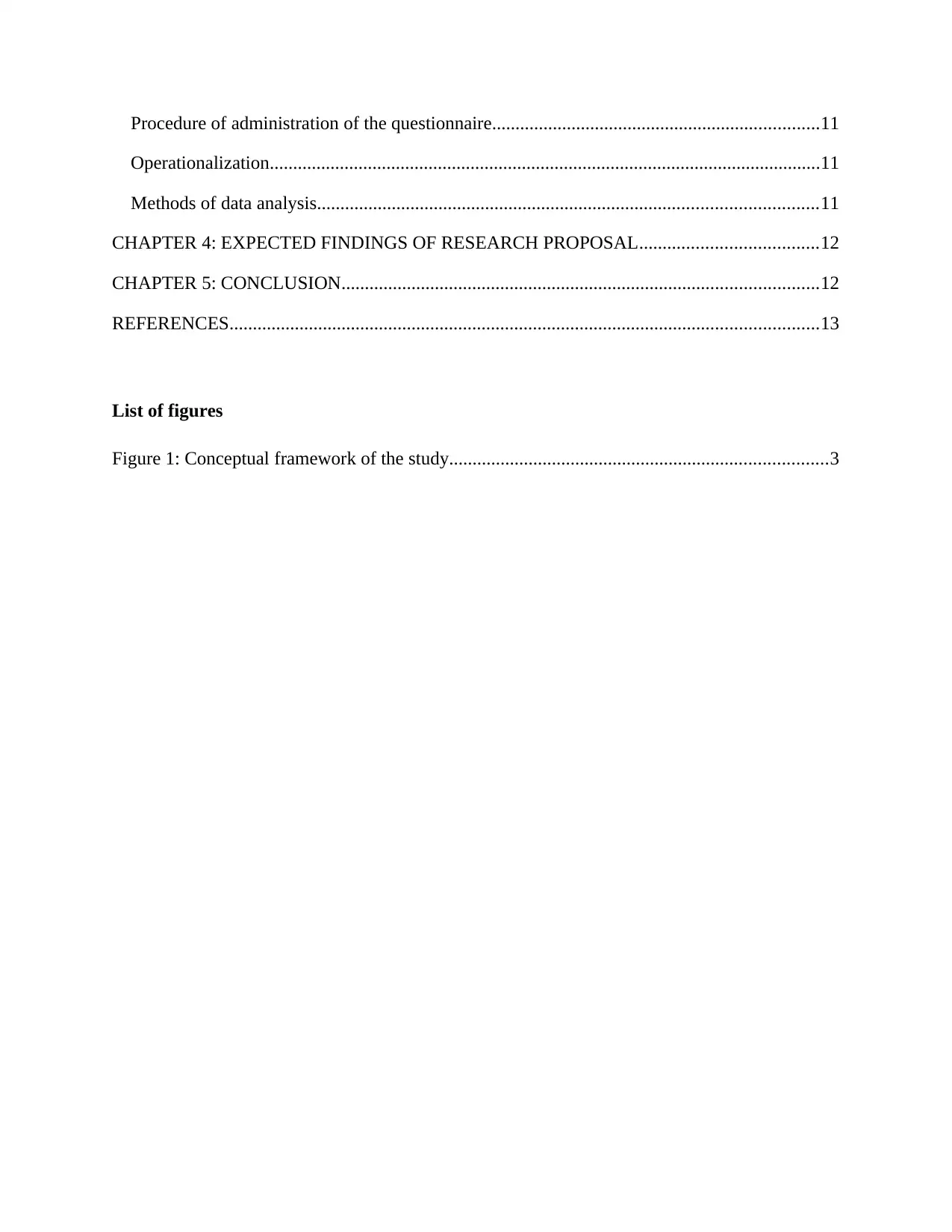
Procedure of administration of the questionnaire......................................................................11
Operationalization......................................................................................................................11
Methods of data analysis...........................................................................................................11
CHAPTER 4: EXPECTED FINDINGS OF RESEARCH PROPOSAL......................................12
CHAPTER 5: CONCLUSION......................................................................................................12
REFERENCES..............................................................................................................................13
List of figures
Figure 1: Conceptual framework of the study.................................................................................3
Operationalization......................................................................................................................11
Methods of data analysis...........................................................................................................11
CHAPTER 4: EXPECTED FINDINGS OF RESEARCH PROPOSAL......................................12
CHAPTER 5: CONCLUSION......................................................................................................12
REFERENCES..............................................................................................................................13
List of figures
Figure 1: Conceptual framework of the study.................................................................................3
⊘ This is a preview!⊘
Do you want full access?
Subscribe today to unlock all pages.

Trusted by 1+ million students worldwide
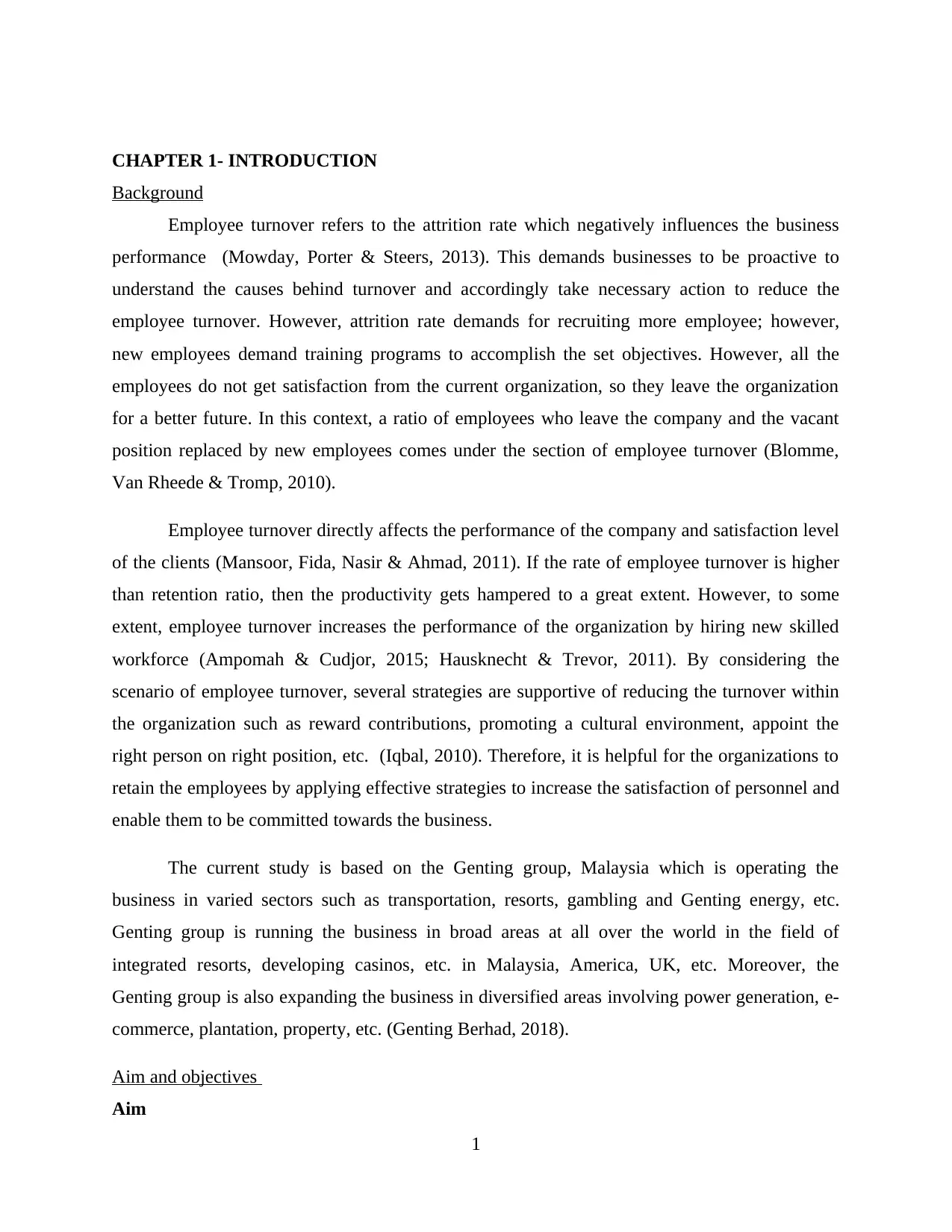
CHAPTER 1- INTRODUCTION
Background
Employee turnover refers to the attrition rate which negatively influences the business
performance (Mowday, Porter & Steers, 2013). This demands businesses to be proactive to
understand the causes behind turnover and accordingly take necessary action to reduce the
employee turnover. However, attrition rate demands for recruiting more employee; however,
new employees demand training programs to accomplish the set objectives. However, all the
employees do not get satisfaction from the current organization, so they leave the organization
for a better future. In this context, a ratio of employees who leave the company and the vacant
position replaced by new employees comes under the section of employee turnover (Blomme,
Van Rheede & Tromp, 2010).
Employee turnover directly affects the performance of the company and satisfaction level
of the clients (Mansoor, Fida, Nasir & Ahmad, 2011). If the rate of employee turnover is higher
than retention ratio, then the productivity gets hampered to a great extent. However, to some
extent, employee turnover increases the performance of the organization by hiring new skilled
workforce (Ampomah & Cudjor, 2015; Hausknecht & Trevor, 2011). By considering the
scenario of employee turnover, several strategies are supportive of reducing the turnover within
the organization such as reward contributions, promoting a cultural environment, appoint the
right person on right position, etc. (Iqbal, 2010). Therefore, it is helpful for the organizations to
retain the employees by applying effective strategies to increase the satisfaction of personnel and
enable them to be committed towards the business.
The current study is based on the Genting group, Malaysia which is operating the
business in varied sectors such as transportation, resorts, gambling and Genting energy, etc.
Genting group is running the business in broad areas at all over the world in the field of
integrated resorts, developing casinos, etc. in Malaysia, America, UK, etc. Moreover, the
Genting group is also expanding the business in diversified areas involving power generation, e-
commerce, plantation, property, etc. (Genting Berhad, 2018).
Aim and objectives
Aim
1
Background
Employee turnover refers to the attrition rate which negatively influences the business
performance (Mowday, Porter & Steers, 2013). This demands businesses to be proactive to
understand the causes behind turnover and accordingly take necessary action to reduce the
employee turnover. However, attrition rate demands for recruiting more employee; however,
new employees demand training programs to accomplish the set objectives. However, all the
employees do not get satisfaction from the current organization, so they leave the organization
for a better future. In this context, a ratio of employees who leave the company and the vacant
position replaced by new employees comes under the section of employee turnover (Blomme,
Van Rheede & Tromp, 2010).
Employee turnover directly affects the performance of the company and satisfaction level
of the clients (Mansoor, Fida, Nasir & Ahmad, 2011). If the rate of employee turnover is higher
than retention ratio, then the productivity gets hampered to a great extent. However, to some
extent, employee turnover increases the performance of the organization by hiring new skilled
workforce (Ampomah & Cudjor, 2015; Hausknecht & Trevor, 2011). By considering the
scenario of employee turnover, several strategies are supportive of reducing the turnover within
the organization such as reward contributions, promoting a cultural environment, appoint the
right person on right position, etc. (Iqbal, 2010). Therefore, it is helpful for the organizations to
retain the employees by applying effective strategies to increase the satisfaction of personnel and
enable them to be committed towards the business.
The current study is based on the Genting group, Malaysia which is operating the
business in varied sectors such as transportation, resorts, gambling and Genting energy, etc.
Genting group is running the business in broad areas at all over the world in the field of
integrated resorts, developing casinos, etc. in Malaysia, America, UK, etc. Moreover, the
Genting group is also expanding the business in diversified areas involving power generation, e-
commerce, plantation, property, etc. (Genting Berhad, 2018).
Aim and objectives
Aim
1
Paraphrase This Document
Need a fresh take? Get an instant paraphrase of this document with our AI Paraphraser
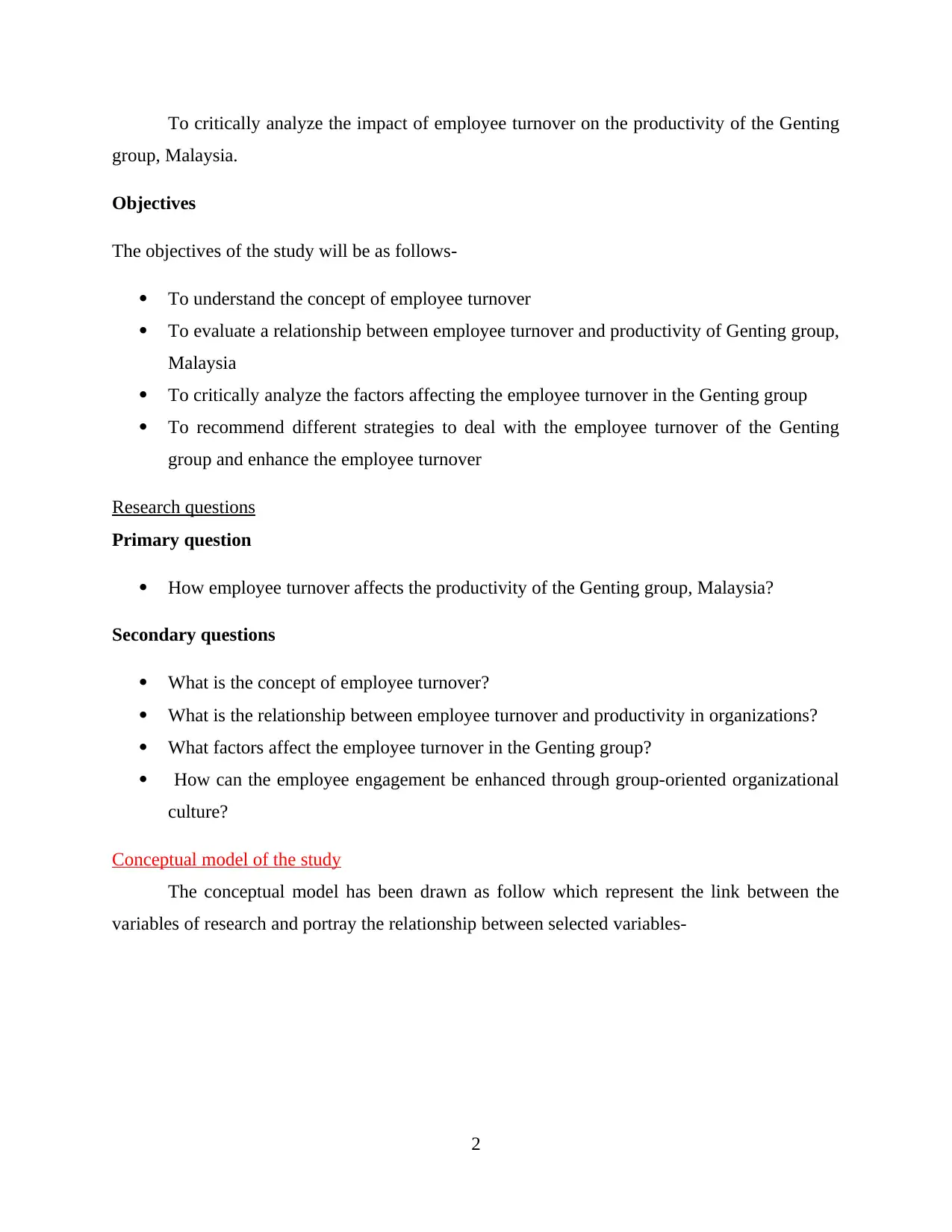
To critically analyze the impact of employee turnover on the productivity of the Genting
group, Malaysia.
Objectives
The objectives of the study will be as follows-
To understand the concept of employee turnover
To evaluate a relationship between employee turnover and productivity of Genting group,
Malaysia
To critically analyze the factors affecting the employee turnover in the Genting group
To recommend different strategies to deal with the employee turnover of the Genting
group and enhance the employee turnover
Research questions
Primary question
How employee turnover affects the productivity of the Genting group, Malaysia?
Secondary questions
What is the concept of employee turnover?
What is the relationship between employee turnover and productivity in organizations?
What factors affect the employee turnover in the Genting group?
How can the employee engagement be enhanced through group-oriented organizational
culture?
Conceptual model of the study
The conceptual model has been drawn as follow which represent the link between the
variables of research and portray the relationship between selected variables-
2
group, Malaysia.
Objectives
The objectives of the study will be as follows-
To understand the concept of employee turnover
To evaluate a relationship between employee turnover and productivity of Genting group,
Malaysia
To critically analyze the factors affecting the employee turnover in the Genting group
To recommend different strategies to deal with the employee turnover of the Genting
group and enhance the employee turnover
Research questions
Primary question
How employee turnover affects the productivity of the Genting group, Malaysia?
Secondary questions
What is the concept of employee turnover?
What is the relationship between employee turnover and productivity in organizations?
What factors affect the employee turnover in the Genting group?
How can the employee engagement be enhanced through group-oriented organizational
culture?
Conceptual model of the study
The conceptual model has been drawn as follow which represent the link between the
variables of research and portray the relationship between selected variables-
2
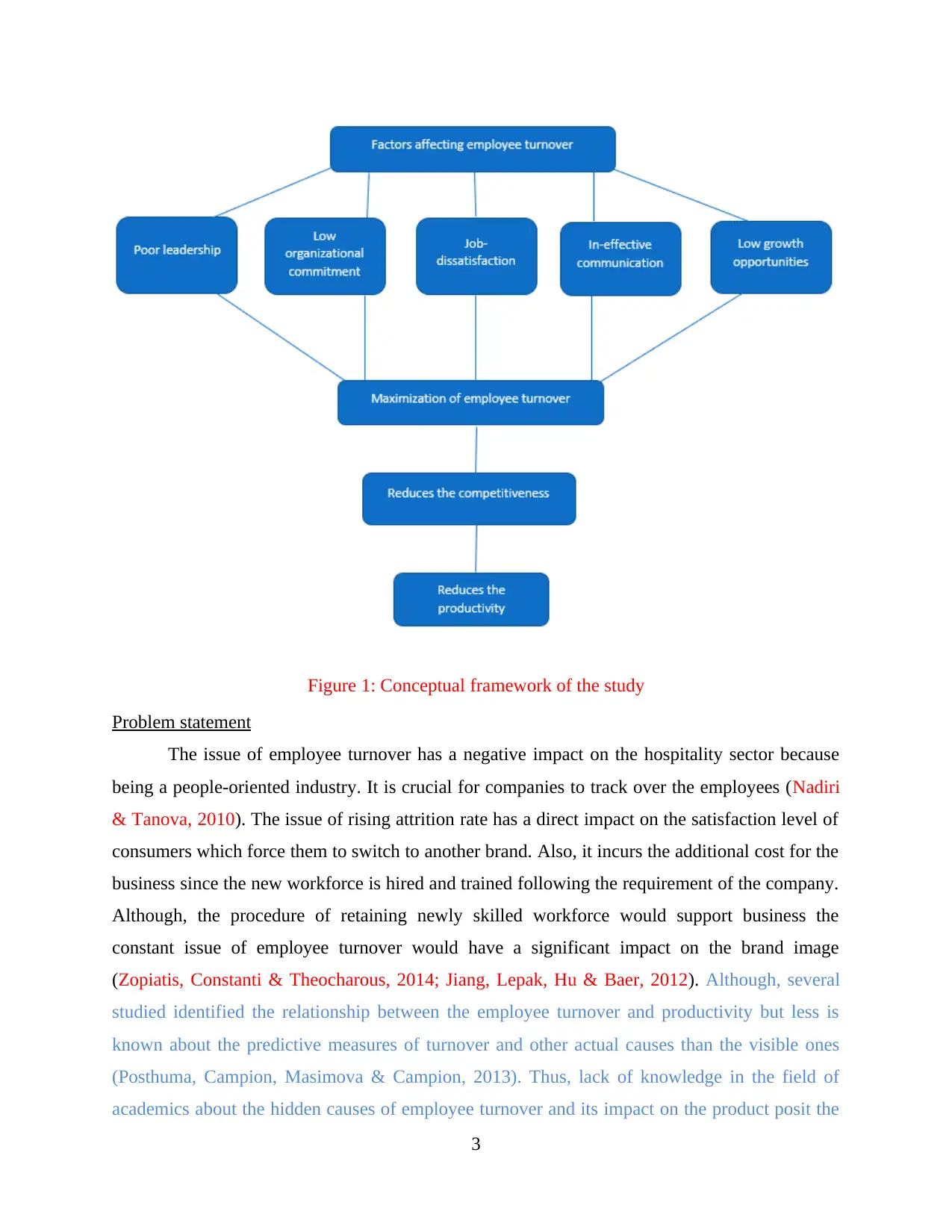
Figure 1: Conceptual framework of the study
Problem statement
The issue of employee turnover has a negative impact on the hospitality sector because
being a people-oriented industry. It is crucial for companies to track over the employees (Nadiri
& Tanova, 2010). The issue of rising attrition rate has a direct impact on the satisfaction level of
consumers which force them to switch to another brand. Also, it incurs the additional cost for the
business since the new workforce is hired and trained following the requirement of the company.
Although, the procedure of retaining newly skilled workforce would support business the
constant issue of employee turnover would have a significant impact on the brand image
(Zopiatis, Constanti & Theocharous, 2014; Jiang, Lepak, Hu & Baer, 2012). Although, several
studied identified the relationship between the employee turnover and productivity but less is
known about the predictive measures of turnover and other actual causes than the visible ones
(Posthuma, Campion, Masimova & Campion, 2013). Thus, lack of knowledge in the field of
academics about the hidden causes of employee turnover and its impact on the product posit the
3
Problem statement
The issue of employee turnover has a negative impact on the hospitality sector because
being a people-oriented industry. It is crucial for companies to track over the employees (Nadiri
& Tanova, 2010). The issue of rising attrition rate has a direct impact on the satisfaction level of
consumers which force them to switch to another brand. Also, it incurs the additional cost for the
business since the new workforce is hired and trained following the requirement of the company.
Although, the procedure of retaining newly skilled workforce would support business the
constant issue of employee turnover would have a significant impact on the brand image
(Zopiatis, Constanti & Theocharous, 2014; Jiang, Lepak, Hu & Baer, 2012). Although, several
studied identified the relationship between the employee turnover and productivity but less is
known about the predictive measures of turnover and other actual causes than the visible ones
(Posthuma, Campion, Masimova & Campion, 2013). Thus, lack of knowledge in the field of
academics about the hidden causes of employee turnover and its impact on the product posit the
3
⊘ This is a preview!⊘
Do you want full access?
Subscribe today to unlock all pages.

Trusted by 1+ million students worldwide
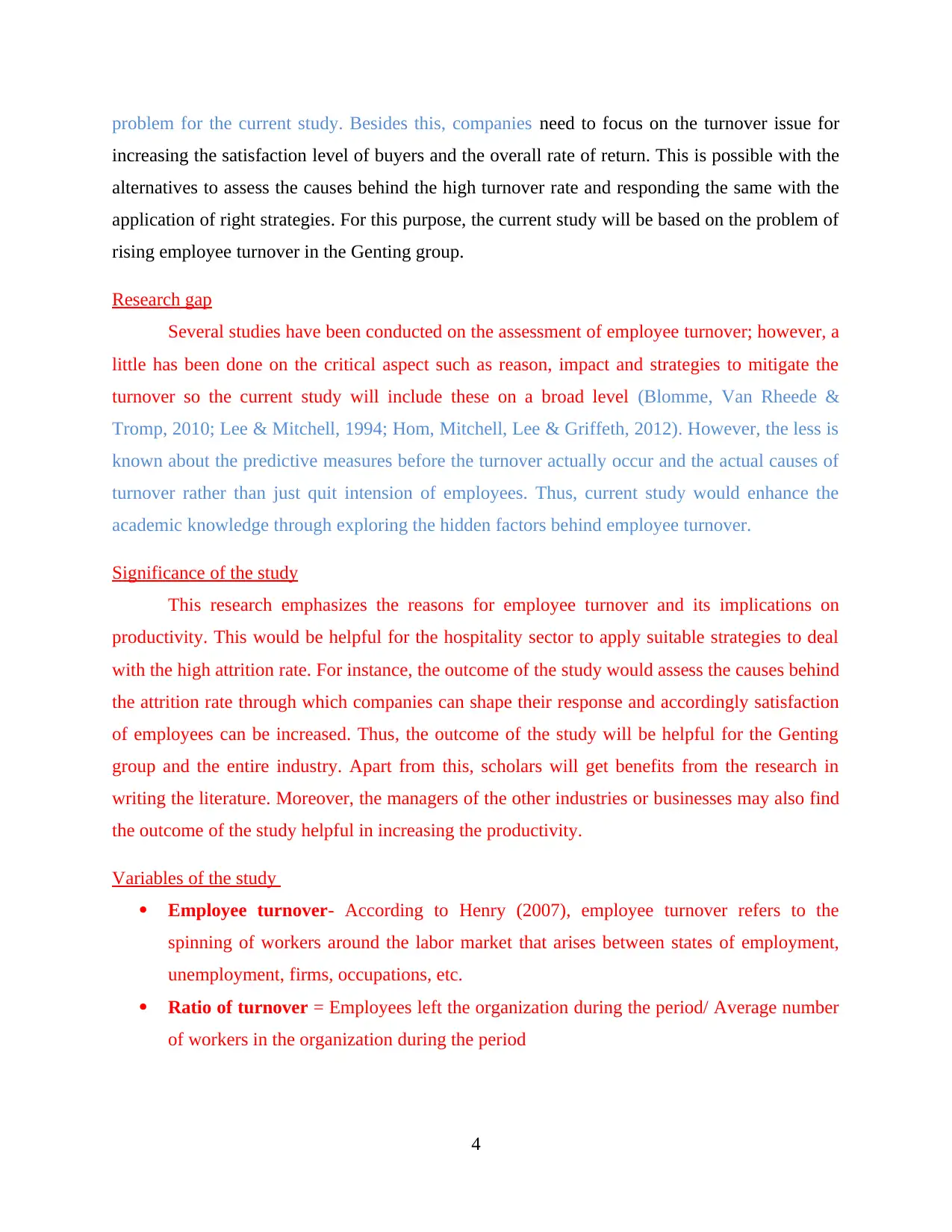
problem for the current study. Besides this, companies need to focus on the turnover issue for
increasing the satisfaction level of buyers and the overall rate of return. This is possible with the
alternatives to assess the causes behind the high turnover rate and responding the same with the
application of right strategies. For this purpose, the current study will be based on the problem of
rising employee turnover in the Genting group.
Research gap
Several studies have been conducted on the assessment of employee turnover; however, a
little has been done on the critical aspect such as reason, impact and strategies to mitigate the
turnover so the current study will include these on a broad level (Blomme, Van Rheede &
Tromp, 2010; Lee & Mitchell, 1994; Hom, Mitchell, Lee & Griffeth, 2012). However, the less is
known about the predictive measures before the turnover actually occur and the actual causes of
turnover rather than just quit intension of employees. Thus, current study would enhance the
academic knowledge through exploring the hidden factors behind employee turnover.
Significance of the study
This research emphasizes the reasons for employee turnover and its implications on
productivity. This would be helpful for the hospitality sector to apply suitable strategies to deal
with the high attrition rate. For instance, the outcome of the study would assess the causes behind
the attrition rate through which companies can shape their response and accordingly satisfaction
of employees can be increased. Thus, the outcome of the study will be helpful for the Genting
group and the entire industry. Apart from this, scholars will get benefits from the research in
writing the literature. Moreover, the managers of the other industries or businesses may also find
the outcome of the study helpful in increasing the productivity.
Variables of the study
Employee turnover- According to Henry (2007), employee turnover refers to the
spinning of workers around the labor market that arises between states of employment,
unemployment, firms, occupations, etc.
Ratio of turnover = Employees left the organization during the period/ Average number
of workers in the organization during the period
4
increasing the satisfaction level of buyers and the overall rate of return. This is possible with the
alternatives to assess the causes behind the high turnover rate and responding the same with the
application of right strategies. For this purpose, the current study will be based on the problem of
rising employee turnover in the Genting group.
Research gap
Several studies have been conducted on the assessment of employee turnover; however, a
little has been done on the critical aspect such as reason, impact and strategies to mitigate the
turnover so the current study will include these on a broad level (Blomme, Van Rheede &
Tromp, 2010; Lee & Mitchell, 1994; Hom, Mitchell, Lee & Griffeth, 2012). However, the less is
known about the predictive measures before the turnover actually occur and the actual causes of
turnover rather than just quit intension of employees. Thus, current study would enhance the
academic knowledge through exploring the hidden factors behind employee turnover.
Significance of the study
This research emphasizes the reasons for employee turnover and its implications on
productivity. This would be helpful for the hospitality sector to apply suitable strategies to deal
with the high attrition rate. For instance, the outcome of the study would assess the causes behind
the attrition rate through which companies can shape their response and accordingly satisfaction
of employees can be increased. Thus, the outcome of the study will be helpful for the Genting
group and the entire industry. Apart from this, scholars will get benefits from the research in
writing the literature. Moreover, the managers of the other industries or businesses may also find
the outcome of the study helpful in increasing the productivity.
Variables of the study
Employee turnover- According to Henry (2007), employee turnover refers to the
spinning of workers around the labor market that arises between states of employment,
unemployment, firms, occupations, etc.
Ratio of turnover = Employees left the organization during the period/ Average number
of workers in the organization during the period
4
Paraphrase This Document
Need a fresh take? Get an instant paraphrase of this document with our AI Paraphraser

Productivity- According to Fletcher & Sarkar (2013), productivity shows a balance
between all the desired factors of the production that provides the higher output with
minimum efforts. Output/Input= Productivity
CHAPTER 2: LITERATURE REVIEW
Concept of employee turnover
Employees turnover is one of the challenges in front of the currently fast-growing
organizations because it creates cost and negative consequences for companies (Iqbal, 2010,
p.275). According to several studies, employee’s turnover related to a ratio in which employees
quit the organization and the vacant positions are replaced by new employees (Mowday, Porter
& Steers, 2013; Jordan & Troth, 2011; Medina, 2012). There are two types of employee’s
turnover including voluntary and non-voluntary. Moreover, employees abandon the organization
at own interest is the voluntary turnover whereas companies put the allegations on the employees
to leave the post or the company lies under non-voluntary turnover (Haines, Jalette & Larose,
2010). Apart from this, Peltokorpi, Allen & Froese (2015) stated that in the current environment,
company policies and regulations of government offer several opportunities for the employees to
join the firm again and perform the business task on a regular basis.
Ponnu & Chuah (2010) stated that employee’s turnover is a common phenomenon in a
competitive business environment; however, entire productivity is getting affected by
employee’s turnover. On the other hand, Koys (2001) asserted that employees turnover affects
the organization in both terms such as positive and negative outcomes. Negative issues resulted
in the form of performance disturbance, more workload and added the cost of recruitment and
selection of new employees. On the contrary, Kehoe & Wright (2013) argued that any type of
employee’s turnover is beneficial for the organizations because it develops the chances of
employment of new skilled employees to maximize the productivity of the business.
Nonetheless, Mosadeghrad, Ferlie & Rosenberg (2011) asserted that high employee’s attrition
rate has an obstructive impact on the organizations because it reduces the morale of other
employees, minimizes the number of customers as well as destroy the image of business at a
global level. Thus, it reveals that employee’s turnover mostly affects the companies in negative
forms and less in positive aspects because it enhances the cost of new hiring and overall
expenses related to employee’s re-employment procedure.
5
between all the desired factors of the production that provides the higher output with
minimum efforts. Output/Input= Productivity
CHAPTER 2: LITERATURE REVIEW
Concept of employee turnover
Employees turnover is one of the challenges in front of the currently fast-growing
organizations because it creates cost and negative consequences for companies (Iqbal, 2010,
p.275). According to several studies, employee’s turnover related to a ratio in which employees
quit the organization and the vacant positions are replaced by new employees (Mowday, Porter
& Steers, 2013; Jordan & Troth, 2011; Medina, 2012). There are two types of employee’s
turnover including voluntary and non-voluntary. Moreover, employees abandon the organization
at own interest is the voluntary turnover whereas companies put the allegations on the employees
to leave the post or the company lies under non-voluntary turnover (Haines, Jalette & Larose,
2010). Apart from this, Peltokorpi, Allen & Froese (2015) stated that in the current environment,
company policies and regulations of government offer several opportunities for the employees to
join the firm again and perform the business task on a regular basis.
Ponnu & Chuah (2010) stated that employee’s turnover is a common phenomenon in a
competitive business environment; however, entire productivity is getting affected by
employee’s turnover. On the other hand, Koys (2001) asserted that employees turnover affects
the organization in both terms such as positive and negative outcomes. Negative issues resulted
in the form of performance disturbance, more workload and added the cost of recruitment and
selection of new employees. On the contrary, Kehoe & Wright (2013) argued that any type of
employee’s turnover is beneficial for the organizations because it develops the chances of
employment of new skilled employees to maximize the productivity of the business.
Nonetheless, Mosadeghrad, Ferlie & Rosenberg (2011) asserted that high employee’s attrition
rate has an obstructive impact on the organizations because it reduces the morale of other
employees, minimizes the number of customers as well as destroy the image of business at a
global level. Thus, it reveals that employee’s turnover mostly affects the companies in negative
forms and less in positive aspects because it enhances the cost of new hiring and overall
expenses related to employee’s re-employment procedure.
5
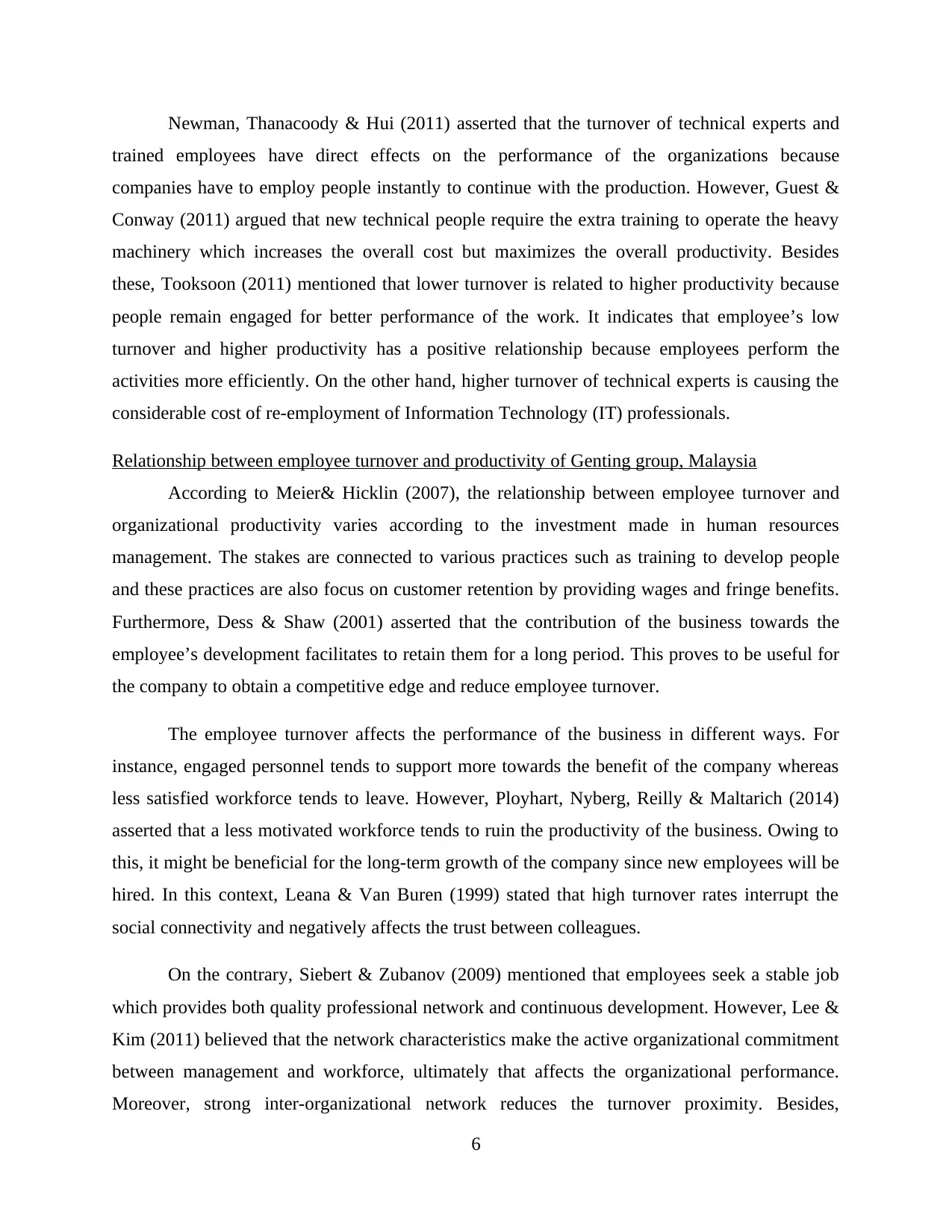
Newman, Thanacoody & Hui (2011) asserted that the turnover of technical experts and
trained employees have direct effects on the performance of the organizations because
companies have to employ people instantly to continue with the production. However, Guest &
Conway (2011) argued that new technical people require the extra training to operate the heavy
machinery which increases the overall cost but maximizes the overall productivity. Besides
these, Tooksoon (2011) mentioned that lower turnover is related to higher productivity because
people remain engaged for better performance of the work. It indicates that employee’s low
turnover and higher productivity has a positive relationship because employees perform the
activities more efficiently. On the other hand, higher turnover of technical experts is causing the
considerable cost of re-employment of Information Technology (IT) professionals.
Relationship between employee turnover and productivity of Genting group, Malaysia
According to Meier& Hicklin (2007), the relationship between employee turnover and
organizational productivity varies according to the investment made in human resources
management. The stakes are connected to various practices such as training to develop people
and these practices are also focus on customer retention by providing wages and fringe benefits.
Furthermore, Dess & Shaw (2001) asserted that the contribution of the business towards the
employee’s development facilitates to retain them for a long period. This proves to be useful for
the company to obtain a competitive edge and reduce employee turnover.
The employee turnover affects the performance of the business in different ways. For
instance, engaged personnel tends to support more towards the benefit of the company whereas
less satisfied workforce tends to leave. However, Ployhart, Nyberg, Reilly & Maltarich (2014)
asserted that a less motivated workforce tends to ruin the productivity of the business. Owing to
this, it might be beneficial for the long-term growth of the company since new employees will be
hired. In this context, Leana & Van Buren (1999) stated that high turnover rates interrupt the
social connectivity and negatively affects the trust between colleagues.
On the contrary, Siebert & Zubanov (2009) mentioned that employees seek a stable job
which provides both quality professional network and continuous development. However, Lee &
Kim (2011) believed that the network characteristics make the active organizational commitment
between management and workforce, ultimately that affects the organizational performance.
Moreover, strong inter-organizational network reduces the turnover proximity. Besides,
6
trained employees have direct effects on the performance of the organizations because
companies have to employ people instantly to continue with the production. However, Guest &
Conway (2011) argued that new technical people require the extra training to operate the heavy
machinery which increases the overall cost but maximizes the overall productivity. Besides
these, Tooksoon (2011) mentioned that lower turnover is related to higher productivity because
people remain engaged for better performance of the work. It indicates that employee’s low
turnover and higher productivity has a positive relationship because employees perform the
activities more efficiently. On the other hand, higher turnover of technical experts is causing the
considerable cost of re-employment of Information Technology (IT) professionals.
Relationship between employee turnover and productivity of Genting group, Malaysia
According to Meier& Hicklin (2007), the relationship between employee turnover and
organizational productivity varies according to the investment made in human resources
management. The stakes are connected to various practices such as training to develop people
and these practices are also focus on customer retention by providing wages and fringe benefits.
Furthermore, Dess & Shaw (2001) asserted that the contribution of the business towards the
employee’s development facilitates to retain them for a long period. This proves to be useful for
the company to obtain a competitive edge and reduce employee turnover.
The employee turnover affects the performance of the business in different ways. For
instance, engaged personnel tends to support more towards the benefit of the company whereas
less satisfied workforce tends to leave. However, Ployhart, Nyberg, Reilly & Maltarich (2014)
asserted that a less motivated workforce tends to ruin the productivity of the business. Owing to
this, it might be beneficial for the long-term growth of the company since new employees will be
hired. In this context, Leana & Van Buren (1999) stated that high turnover rates interrupt the
social connectivity and negatively affects the trust between colleagues.
On the contrary, Siebert & Zubanov (2009) mentioned that employees seek a stable job
which provides both quality professional network and continuous development. However, Lee &
Kim (2011) believed that the network characteristics make the active organizational commitment
between management and workforce, ultimately that affects the organizational performance.
Moreover, strong inter-organizational network reduces the turnover proximity. Besides,
6
⊘ This is a preview!⊘
Do you want full access?
Subscribe today to unlock all pages.

Trusted by 1+ million students worldwide
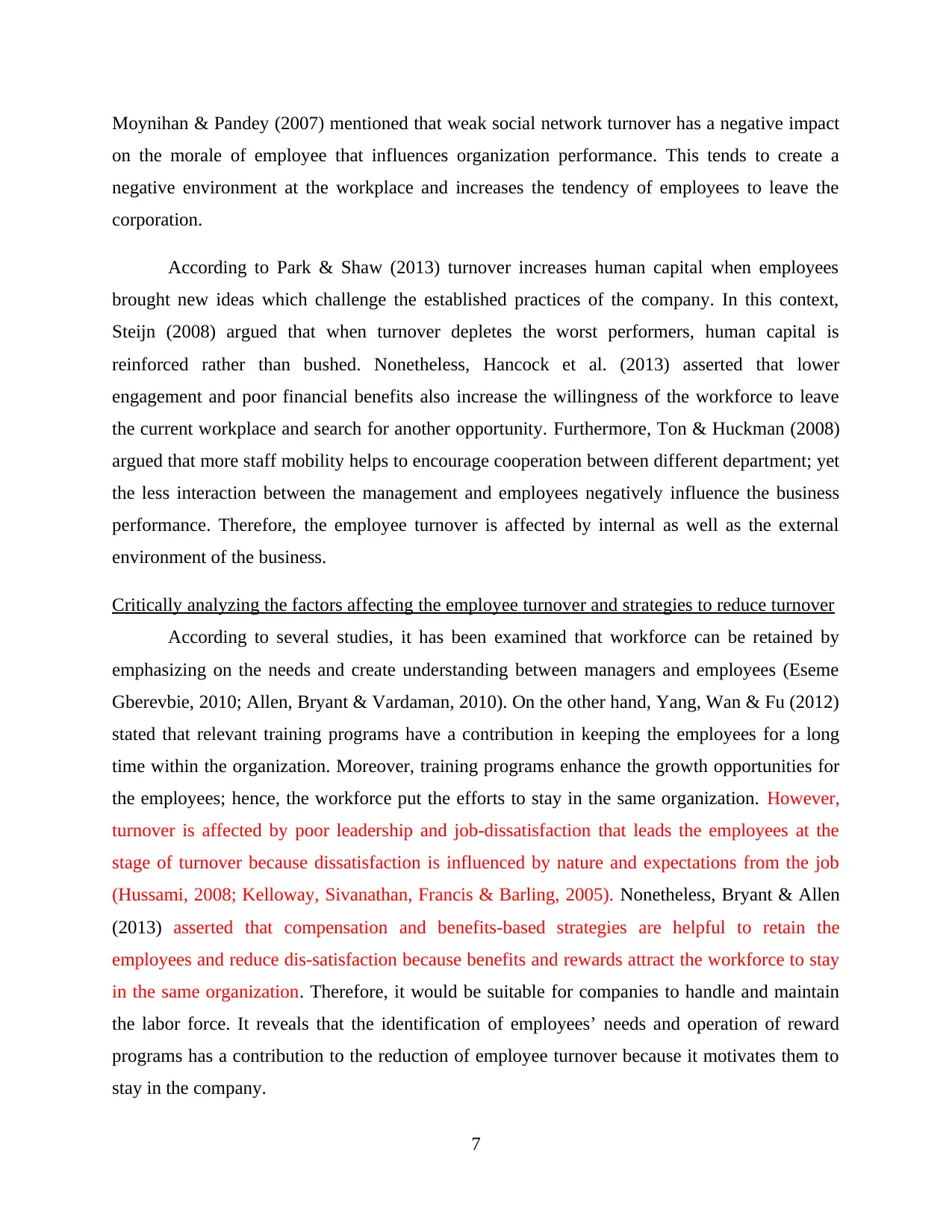
Moynihan & Pandey (2007) mentioned that weak social network turnover has a negative impact
on the morale of employee that influences organization performance. This tends to create a
negative environment at the workplace and increases the tendency of employees to leave the
corporation.
According to Park & Shaw (2013) turnover increases human capital when employees
brought new ideas which challenge the established practices of the company. In this context,
Steijn (2008) argued that when turnover depletes the worst performers, human capital is
reinforced rather than bushed. Nonetheless, Hancock et al. (2013) asserted that lower
engagement and poor financial benefits also increase the willingness of the workforce to leave
the current workplace and search for another opportunity. Furthermore, Ton & Huckman (2008)
argued that more staff mobility helps to encourage cooperation between different department; yet
the less interaction between the management and employees negatively influence the business
performance. Therefore, the employee turnover is affected by internal as well as the external
environment of the business.
Critically analyzing the factors affecting the employee turnover and strategies to reduce turnover
According to several studies, it has been examined that workforce can be retained by
emphasizing on the needs and create understanding between managers and employees (Eseme
Gberevbie, 2010; Allen, Bryant & Vardaman, 2010). On the other hand, Yang, Wan & Fu (2012)
stated that relevant training programs have a contribution in keeping the employees for a long
time within the organization. Moreover, training programs enhance the growth opportunities for
the employees; hence, the workforce put the efforts to stay in the same organization. However,
turnover is affected by poor leadership and job-dissatisfaction that leads the employees at the
stage of turnover because dissatisfaction is influenced by nature and expectations from the job
(Hussami, 2008; Kelloway, Sivanathan, Francis & Barling, 2005). Nonetheless, Bryant & Allen
(2013) asserted that compensation and benefits-based strategies are helpful to retain the
employees and reduce dis-satisfaction because benefits and rewards attract the workforce to stay
in the same organization. Therefore, it would be suitable for companies to handle and maintain
the labor force. It reveals that the identification of employees’ needs and operation of reward
programs has a contribution to the reduction of employee turnover because it motivates them to
stay in the company.
7
on the morale of employee that influences organization performance. This tends to create a
negative environment at the workplace and increases the tendency of employees to leave the
corporation.
According to Park & Shaw (2013) turnover increases human capital when employees
brought new ideas which challenge the established practices of the company. In this context,
Steijn (2008) argued that when turnover depletes the worst performers, human capital is
reinforced rather than bushed. Nonetheless, Hancock et al. (2013) asserted that lower
engagement and poor financial benefits also increase the willingness of the workforce to leave
the current workplace and search for another opportunity. Furthermore, Ton & Huckman (2008)
argued that more staff mobility helps to encourage cooperation between different department; yet
the less interaction between the management and employees negatively influence the business
performance. Therefore, the employee turnover is affected by internal as well as the external
environment of the business.
Critically analyzing the factors affecting the employee turnover and strategies to reduce turnover
According to several studies, it has been examined that workforce can be retained by
emphasizing on the needs and create understanding between managers and employees (Eseme
Gberevbie, 2010; Allen, Bryant & Vardaman, 2010). On the other hand, Yang, Wan & Fu (2012)
stated that relevant training programs have a contribution in keeping the employees for a long
time within the organization. Moreover, training programs enhance the growth opportunities for
the employees; hence, the workforce put the efforts to stay in the same organization. However,
turnover is affected by poor leadership and job-dissatisfaction that leads the employees at the
stage of turnover because dissatisfaction is influenced by nature and expectations from the job
(Hussami, 2008; Kelloway, Sivanathan, Francis & Barling, 2005). Nonetheless, Bryant & Allen
(2013) asserted that compensation and benefits-based strategies are helpful to retain the
employees and reduce dis-satisfaction because benefits and rewards attract the workforce to stay
in the same organization. Therefore, it would be suitable for companies to handle and maintain
the labor force. It reveals that the identification of employees’ needs and operation of reward
programs has a contribution to the reduction of employee turnover because it motivates them to
stay in the company.
7
Paraphrase This Document
Need a fresh take? Get an instant paraphrase of this document with our AI Paraphraser
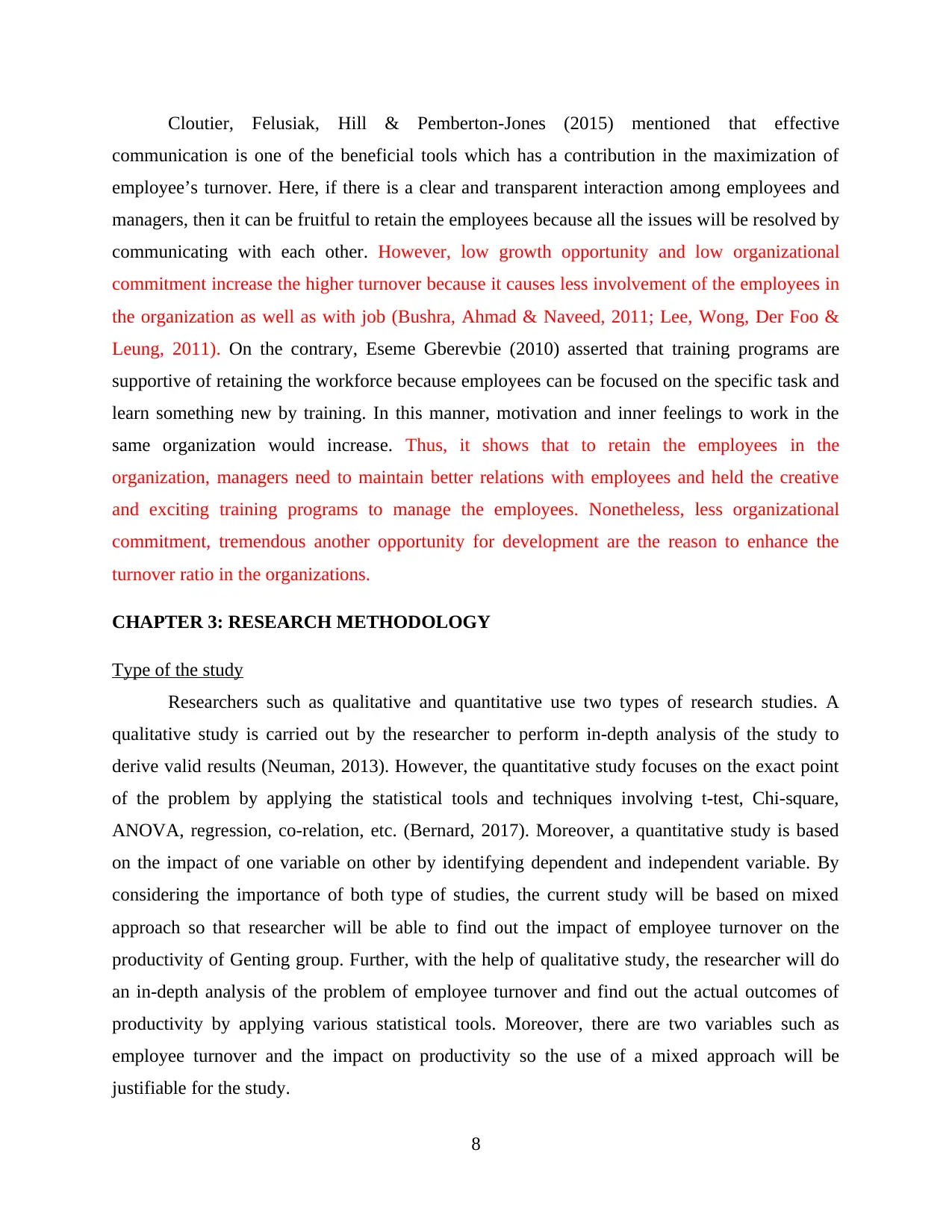
Cloutier, Felusiak, Hill & Pemberton-Jones (2015) mentioned that effective
communication is one of the beneficial tools which has a contribution in the maximization of
employee’s turnover. Here, if there is a clear and transparent interaction among employees and
managers, then it can be fruitful to retain the employees because all the issues will be resolved by
communicating with each other. However, low growth opportunity and low organizational
commitment increase the higher turnover because it causes less involvement of the employees in
the organization as well as with job (Bushra, Ahmad & Naveed, 2011; Lee, Wong, Der Foo &
Leung, 2011). On the contrary, Eseme Gberevbie (2010) asserted that training programs are
supportive of retaining the workforce because employees can be focused on the specific task and
learn something new by training. In this manner, motivation and inner feelings to work in the
same organization would increase. Thus, it shows that to retain the employees in the
organization, managers need to maintain better relations with employees and held the creative
and exciting training programs to manage the employees. Nonetheless, less organizational
commitment, tremendous another opportunity for development are the reason to enhance the
turnover ratio in the organizations.
CHAPTER 3: RESEARCH METHODOLOGY
Type of the study
Researchers such as qualitative and quantitative use two types of research studies. A
qualitative study is carried out by the researcher to perform in-depth analysis of the study to
derive valid results (Neuman, 2013). However, the quantitative study focuses on the exact point
of the problem by applying the statistical tools and techniques involving t-test, Chi-square,
ANOVA, regression, co-relation, etc. (Bernard, 2017). Moreover, a quantitative study is based
on the impact of one variable on other by identifying dependent and independent variable. By
considering the importance of both type of studies, the current study will be based on mixed
approach so that researcher will be able to find out the impact of employee turnover on the
productivity of Genting group. Further, with the help of qualitative study, the researcher will do
an in-depth analysis of the problem of employee turnover and find out the actual outcomes of
productivity by applying various statistical tools. Moreover, there are two variables such as
employee turnover and the impact on productivity so the use of a mixed approach will be
justifiable for the study.
8
communication is one of the beneficial tools which has a contribution in the maximization of
employee’s turnover. Here, if there is a clear and transparent interaction among employees and
managers, then it can be fruitful to retain the employees because all the issues will be resolved by
communicating with each other. However, low growth opportunity and low organizational
commitment increase the higher turnover because it causes less involvement of the employees in
the organization as well as with job (Bushra, Ahmad & Naveed, 2011; Lee, Wong, Der Foo &
Leung, 2011). On the contrary, Eseme Gberevbie (2010) asserted that training programs are
supportive of retaining the workforce because employees can be focused on the specific task and
learn something new by training. In this manner, motivation and inner feelings to work in the
same organization would increase. Thus, it shows that to retain the employees in the
organization, managers need to maintain better relations with employees and held the creative
and exciting training programs to manage the employees. Nonetheless, less organizational
commitment, tremendous another opportunity for development are the reason to enhance the
turnover ratio in the organizations.
CHAPTER 3: RESEARCH METHODOLOGY
Type of the study
Researchers such as qualitative and quantitative use two types of research studies. A
qualitative study is carried out by the researcher to perform in-depth analysis of the study to
derive valid results (Neuman, 2013). However, the quantitative study focuses on the exact point
of the problem by applying the statistical tools and techniques involving t-test, Chi-square,
ANOVA, regression, co-relation, etc. (Bernard, 2017). Moreover, a quantitative study is based
on the impact of one variable on other by identifying dependent and independent variable. By
considering the importance of both type of studies, the current study will be based on mixed
approach so that researcher will be able to find out the impact of employee turnover on the
productivity of Genting group. Further, with the help of qualitative study, the researcher will do
an in-depth analysis of the problem of employee turnover and find out the actual outcomes of
productivity by applying various statistical tools. Moreover, there are two variables such as
employee turnover and the impact on productivity so the use of a mixed approach will be
justifiable for the study.
8
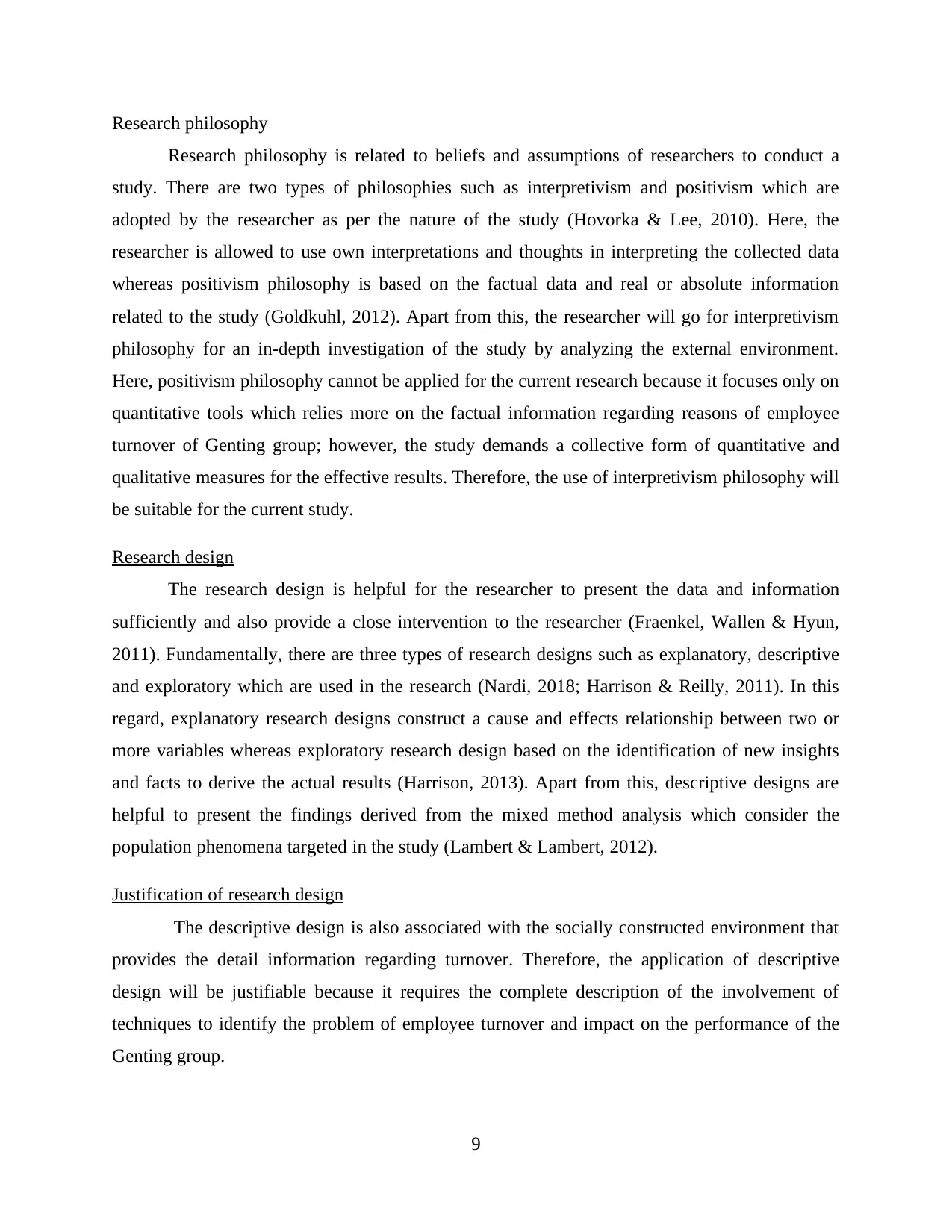
Research philosophy
Research philosophy is related to beliefs and assumptions of researchers to conduct a
study. There are two types of philosophies such as interpretivism and positivism which are
adopted by the researcher as per the nature of the study (Hovorka & Lee, 2010). Here, the
researcher is allowed to use own interpretations and thoughts in interpreting the collected data
whereas positivism philosophy is based on the factual data and real or absolute information
related to the study (Goldkuhl, 2012). Apart from this, the researcher will go for interpretivism
philosophy for an in-depth investigation of the study by analyzing the external environment.
Here, positivism philosophy cannot be applied for the current research because it focuses only on
quantitative tools which relies more on the factual information regarding reasons of employee
turnover of Genting group; however, the study demands a collective form of quantitative and
qualitative measures for the effective results. Therefore, the use of interpretivism philosophy will
be suitable for the current study.
Research design
The research design is helpful for the researcher to present the data and information
sufficiently and also provide a close intervention to the researcher (Fraenkel, Wallen & Hyun,
2011). Fundamentally, there are three types of research designs such as explanatory, descriptive
and exploratory which are used in the research (Nardi, 2018; Harrison & Reilly, 2011). In this
regard, explanatory research designs construct a cause and effects relationship between two or
more variables whereas exploratory research design based on the identification of new insights
and facts to derive the actual results (Harrison, 2013). Apart from this, descriptive designs are
helpful to present the findings derived from the mixed method analysis which consider the
population phenomena targeted in the study (Lambert & Lambert, 2012).
Justification of research design
The descriptive design is also associated with the socially constructed environment that
provides the detail information regarding turnover. Therefore, the application of descriptive
design will be justifiable because it requires the complete description of the involvement of
techniques to identify the problem of employee turnover and impact on the performance of the
Genting group.
9
Research philosophy is related to beliefs and assumptions of researchers to conduct a
study. There are two types of philosophies such as interpretivism and positivism which are
adopted by the researcher as per the nature of the study (Hovorka & Lee, 2010). Here, the
researcher is allowed to use own interpretations and thoughts in interpreting the collected data
whereas positivism philosophy is based on the factual data and real or absolute information
related to the study (Goldkuhl, 2012). Apart from this, the researcher will go for interpretivism
philosophy for an in-depth investigation of the study by analyzing the external environment.
Here, positivism philosophy cannot be applied for the current research because it focuses only on
quantitative tools which relies more on the factual information regarding reasons of employee
turnover of Genting group; however, the study demands a collective form of quantitative and
qualitative measures for the effective results. Therefore, the use of interpretivism philosophy will
be suitable for the current study.
Research design
The research design is helpful for the researcher to present the data and information
sufficiently and also provide a close intervention to the researcher (Fraenkel, Wallen & Hyun,
2011). Fundamentally, there are three types of research designs such as explanatory, descriptive
and exploratory which are used in the research (Nardi, 2018; Harrison & Reilly, 2011). In this
regard, explanatory research designs construct a cause and effects relationship between two or
more variables whereas exploratory research design based on the identification of new insights
and facts to derive the actual results (Harrison, 2013). Apart from this, descriptive designs are
helpful to present the findings derived from the mixed method analysis which consider the
population phenomena targeted in the study (Lambert & Lambert, 2012).
Justification of research design
The descriptive design is also associated with the socially constructed environment that
provides the detail information regarding turnover. Therefore, the application of descriptive
design will be justifiable because it requires the complete description of the involvement of
techniques to identify the problem of employee turnover and impact on the performance of the
Genting group.
9
⊘ This is a preview!⊘
Do you want full access?
Subscribe today to unlock all pages.

Trusted by 1+ million students worldwide
1 out of 22
Related Documents
Your All-in-One AI-Powered Toolkit for Academic Success.
+13062052269
info@desklib.com
Available 24*7 on WhatsApp / Email
![[object Object]](/_next/static/media/star-bottom.7253800d.svg)
Unlock your academic potential
Copyright © 2020–2025 A2Z Services. All Rights Reserved. Developed and managed by ZUCOL.




